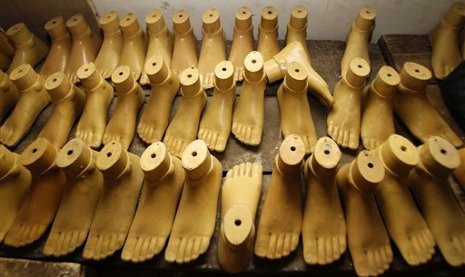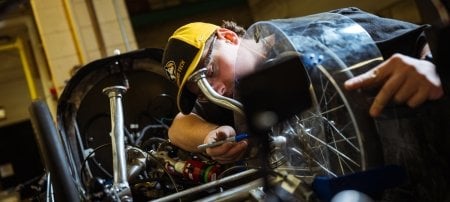Senior Design Teams Tackle Jaipur Foot Challenge

Most of us would rather hop in a car than walk. Walking has become something of a lost art.
But what if you couldn’t walk?
A low-cost solution for those needing a lower limb replacement has been the Jaipur foot. The prosthetic designed in India has helped millions around the world walk again.
The foot only lasts two or three years, though. So an International Senior Capstone Design team at Michigan Technological University took on the task of improving the foot’s performance. Their goal was to increase the foot’s longevity while reducing its weight and improving overall flexibility.
The effort has been funded by the Department of Mechanical Engineering-Engineering Mechanics to provide students with a global experience.
It was a formidable challenge. First, says former team member Marcel Kerkove, the students had to analyze “how the foot was currently made, obtain the necessary equipment and materials, and become skilled at shaping and assembling the foot by hand.” Once they had the basics down, the team was able to begin designing and testing a new model foot.
They came up with a foot that was about 5 ounces lighter than the current production model, with the overall cost rising only $6. But, after testing and consultation with the team’s sponsors in India—where the team of four mechanical and two biomedical engineering students saw the use and need for their work firsthand—they discovered a problem with the prototype.
“Further testing revealed that material compatibility issues the team wrestled with had not fully been resolved,” Kerkove recalls. “A lower density foam we used to replace some of the foam rubber in their design did not interface well with the outer rubber layers.”
This problem will be the challenge confronting a new senior design team, as Kerkove and his teammates have moved on to graduate school or careers. Kerkove now is a PhD candidate in Materials Science and Engineering, working on aluminum alloy systems with the US Navy.
Kerkove and the others look back on their work with the Jaipur foot as important personally, professionally and for the reputation of American engineering. “Our project showed people in India that students in engineering in this country are do care about humanitarian issues across the world.”
Michigan Technological University is a public research university founded in 1885 in Houghton, Michigan, and is home to more than 7,000 students from 55 countries around the world. Consistently ranked among the best universities in the country for return on investment, Michigan’s flagship technological university offers more than 120 undergraduate and graduate degree programs in science and technology, engineering, computing, forestry, business and economics, health professions, humanities, mathematics, social sciences, and the arts. The rural campus is situated just miles from Lake Superior in Michigan's Upper Peninsula, offering year-round opportunities for outdoor adventure.




Comments